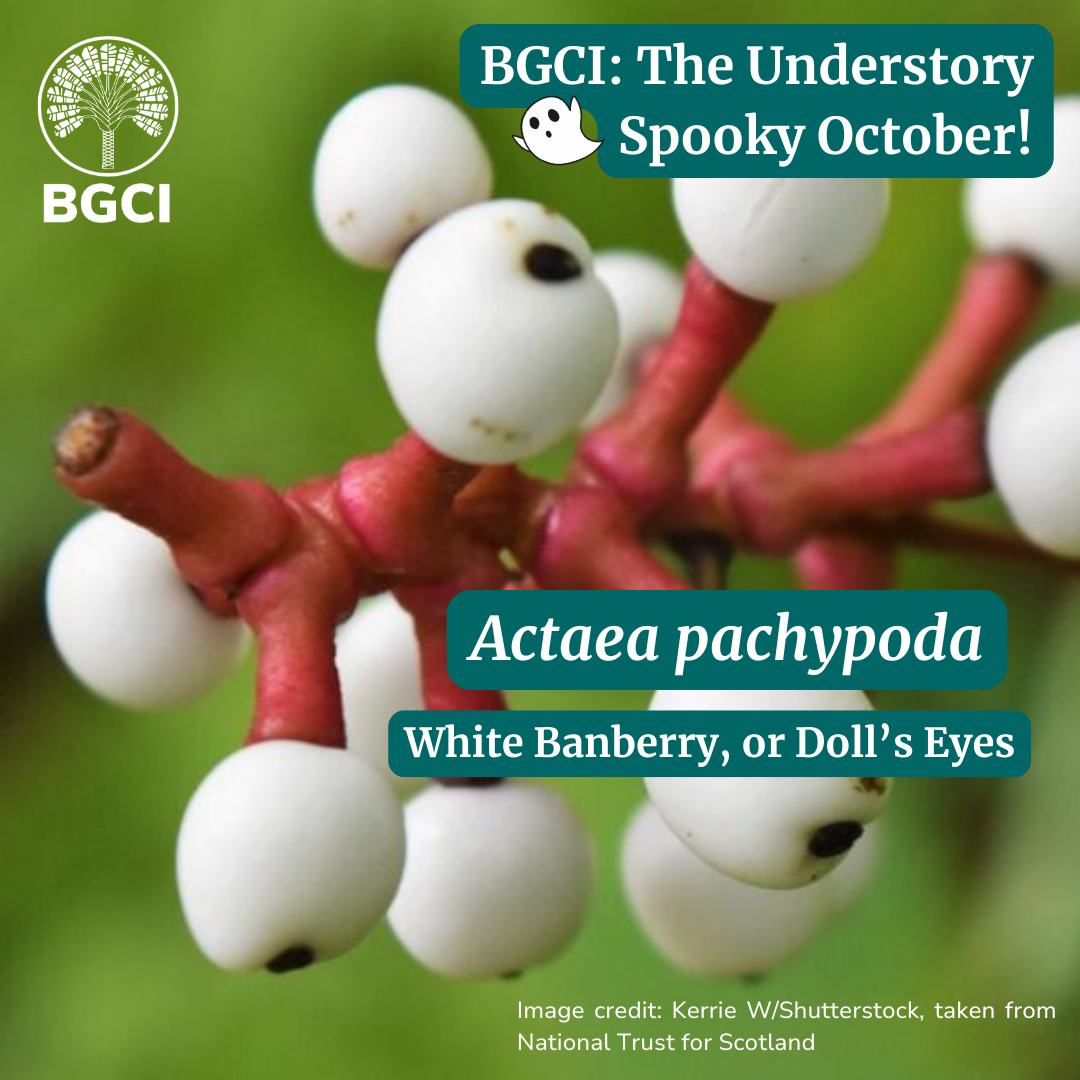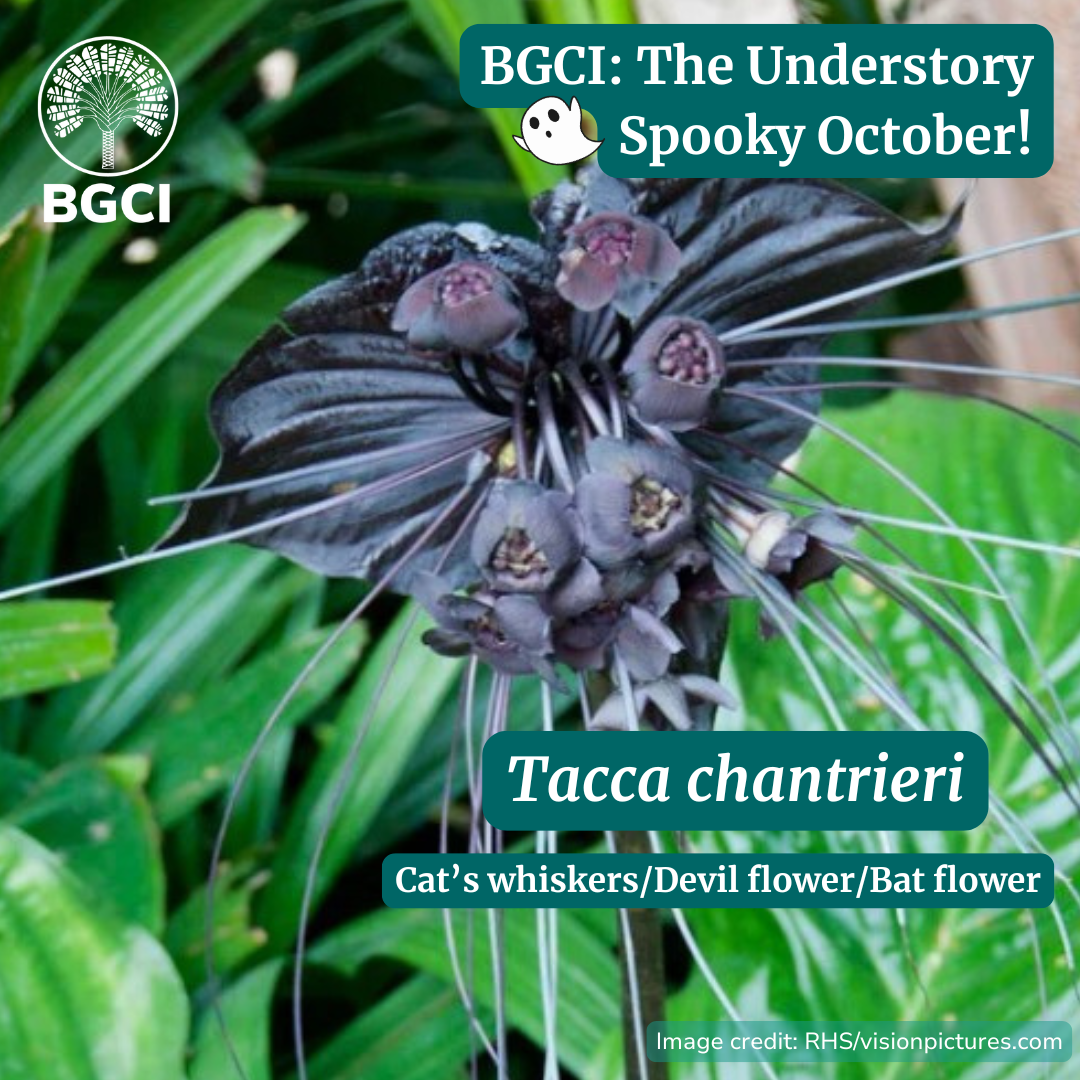Halloween Horticulture 2024!
-
Region
Global -
Programme
The Understory -
Workstream
Sharing Knowledge and Resources -
Topic
Public Engagement -
Type
Blog -
Source
BGCI
News Published: 31 October 2024
If you follow us on social media, you will have seen us share some spooky plants throughout October, but here is a round-up with a little more info on the different species that we covered.
We start off our look into Halloween Horticulture with the magnificent Corpse Flower (Amorphophallus Titanum).
This impressive plant may only bloom every 7-9 years and last just 24-36 hours, but when it does – it makes itself known! The bloom smells like rotting flesh to attract pollinators such as flesh flies and dung beetles, which ensure the continuation of the species. Not content with being one of the stinkiest flowers, it is also the largest flowering structure in the world – with the tallest bloom being recorded at over 10 feet tall!
FUN FACT: When not in bloom, this plant produces a vibrant red/orange fruit which although being incredibly poisonous to humans, they are eaten by other species in the wild, such as Rhinoceros Hornbills.
This plant is found in rainforests in Western Sumatra (Indonesia), however, unfortunately it will be hard to find one as there are reportedly less than 1,000 individuals left in the wild, with this species being classed as Endangered by IUCN. The main threats including population fragmentation due to habitat loss. But good news – you can find this species in botanic gardens – and when they are due to bloom, the excitement means that they are widely publicised and made accessible with extended opening hour and live webcams.
Why not look at whether there is one in a garden near you?

Actaea pachypoda, or White Baneberry, is also known colloquially as Doll’s Eyes. This is due to the white fruits that look like they could be staring up at you from the plant. This is undoubtedly spooky, but in addition, these plants are also entirely poisonous to humans, with the ingestion of berries potentially leading to cardiac arrest and death. So – if you see one of these plants staring up at you, maybe just give it a nod and walk on by.
FUN FACT: Despite being poisonous to humans and other mammals, they are still eaten by birds which disperse the seeds and are pollinate by long-tongued bees.
Native to eastern North America, eastern Canada, and the Midwestern and Eastern US, this plant does seem to be surviving well in the wild and is widely cultivated as an ornamental plant. This plant grows to approximately 30 inches in height, with the berries ripening over the summer through to the first frost.
This plant is a popular species to spot for those using sites such as iNaturalist. With it’s distinctive look, it is an easy species to identify when out in nature.
Have you spotted this species looking at you?

Tacca chantrieri is pretty goth, in several ways! Its common names include; cat’s whiskers, devil flower, or bat flower. It is native to more tropical regions, however, it is popular in horticulture due to its striking, unique appearance. It is a fascinating species which is reported to be mostly self-pollinating. The plant can grow up to 1 metre tall, with the flowers measuring up to 12 inches across, and the long ‘whiskers’ reaching up to 10 inches.
FUN FACT: This species is commonly used in traditional Chinese medicine to treat several ailments, including complex health issues such as cancer.
There are many discussions based around why this plant has such a distinctive appearance with the leading ideas including;
- Flowers previously had a fetid smell which, coupled with its colour, attracted pollinators.
- The long whiskers aid in photosynthesis within low light habitats.
- It attracted a specific pollinator which is sadly now extinct.
Why do you think this species looks the way it does?

We couldn’t list spooky plants without mentioning the iconic Venus Flytrap (Dionaea muscipula). With numerous features across popular culture, this carnivorous plant is infamous for its ability to attract, trap, and then breakdown its prey using enzymes. The snapping shut of the trap takes less than a second but to fully digest the prey and absorb the nutrients can take about 10 days. Once the process is complete, the leaf reopens, and the trap is set again to attract its next victim!
FUN FACT: The sensory hairs which snap the trap shut are called ‘trichomes’.
Venus Flytraps grow in the wild across North and South Carolina in the US but have begun to be seen in other states. The grow up to 30cm/12 inches tall. The iconic ‘trap’ is a set of hinged leaves which are covered in sensitive hairs that, when touched, spring the trap to catch their prey. However, to avoid expelling unnecessary energy of springing the trap for non-prey items, such as falling leaves, the hairs must be triggered 2 times within 20 seconds for the trap to shut. Desired pray items include; ants, flies, beetles, slugs, spiders, and even small frogs.
Venus Flytraps are considered Vulnerable on the IUCN Red List, with threats including being over-harvested for the plant trade and overall habitat loss.

There are so many spooky species to be found in the natural world. What are you favourites?
Want to see more of our science communication efforts? Visit The Understory section of the website to see all the content in one place – and don’t forget to find us on all the usual social media platforms!
Become a Member
Be part of the largest network of botanic gardens and plant conservation experts in the world by joining BGCI today!
Support BGCI
You can support our plant conservation efforts by sponsoring membership for small botanic gardens, contributing to the Global Botanic Garden Fund, and more!